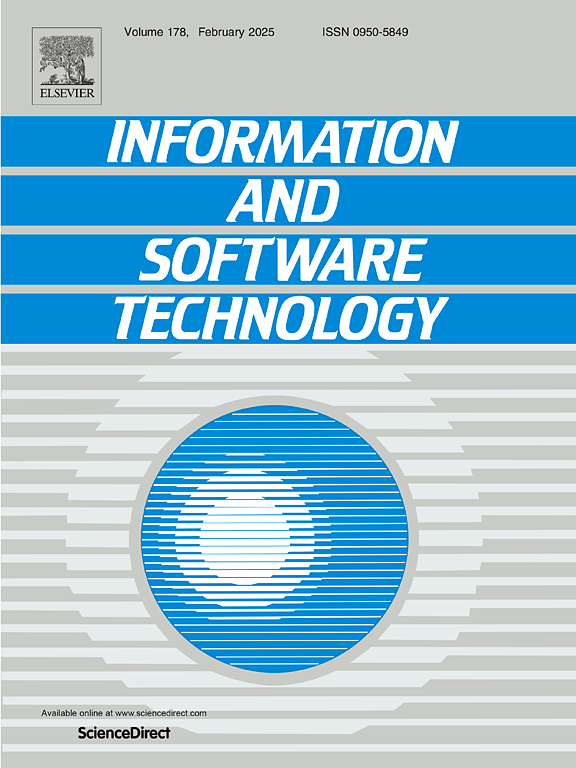基于加权玻尔兹曼熵的面向软件老化的可信度测量
IF 3.8
2区 计算机科学
Q2 COMPUTER SCIENCE, INFORMATION SYSTEMS
引用次数: 0
摘要
背景:随着软件的快速发展,各种软件事故层出不穷。这些事故造成的灾难性后果让人们意识到软件可信度的重要性。作为保证软件质量不可或缺的手段,传统的可信度测评是通过研究静态的可信属性来评价软件的可信度。然而,可信属性中考虑的大多数因素往往是随时间变化的动态因素。本文旨在研究运行时间与软件可信度之间的关系,并从与软件老化相关的不可信证据中设计出与运行时间相关的软件可信度度量模型。方法:首先,我们从 4 个公共缺陷数据库的 5 个子系统中与软件老化相关的 bug 和 18 个知名软件事故中提取不可信证据,建立风险等级模型,并设计基于软件老化的不可信证据度量要素。然后,我们构建了基于玻尔兹曼熵的软件老化原因类别可信度度量模型。最后,我们建立了基于加权波尔兹曼熵的软件可信度度量模型。结果:与常见的资源消耗参数和性能参数不同,基于加权玻尔兹曼熵的模型可以通过风险状态来描述各种参数对软件可信度的影响。结论:实证研究表明,我们的软件动态可信度评估方法是有效和实用的。结论:实证研究表明了我们的软件动态可信度评估方法的有效性和实用性,同时也为今后软件可信度测量领域的研究和应用指明了方向。本文章由计算机程序翻译,如有差异,请以英文原文为准。
Software aging oriented trustworthiness measurement based on weighted Boltzmann entropy
Context:
With the rapid development of software, various software accidents emerge one after another. The catastrophic consequences caused by these accidents make people realize the importance of software trustworthiness. As an indispensable means to ensure software quality, traditional trustworthiness measurement evaluates the software trustworthiness by studying the trustworthy attributes in a static way. However, most of the factors considered in trustworthy attributes tend to be dynamic with time. The current research often ignores the changes in software after running for some time, and cannot reflect the changes in software trustworthiness at different running times.
Objective:
Our objective in this paper is to study the relationship between running time and software trustworthiness, and design a running time-related software trustworthiness measurement model from the untrustworthy evidence related to software aging.
Method:
We first extract the untrustworthy evidence from the bugs related to software aging in 5 subsystems of 4 public defect databases and 18 well-known software accidents, establish a risk level model, and design metric elements of untrustworthy evidence based on software aging. Then we construct a software aging cause category trustworthiness measurement model based on Boltzmann entropy. Finally, we build a software trustworthiness measurement model based on weighted Boltzmann entropy. For the weight values used in the model, the Brassard Priority Synthesis Analysis method was used to determine them.
Result:
Different from the common resource consumption parameter and performance parameter, a model based on weighted Boltzmann entropy can describe the influence of various parameters on the software’s trustworthiness through risk state. It can reflect the change of system state and describe the system state completely.
Conclusion:
The empirical study shows the effectiveness and practicality of our method for evaluating software dynamic trustworthiness. Meanwhile, it also indicates a promising avenue for future research and application in the field of software trustworthiness measurement.
求助全文
通过发布文献求助,成功后即可免费获取论文全文。
去求助
来源期刊

Information and Software Technology
工程技术-计算机:软件工程
CiteScore
9.10
自引率
7.70%
发文量
164
审稿时长
9.6 weeks
期刊介绍:
Information and Software Technology is the international archival journal focusing on research and experience that contributes to the improvement of software development practices. The journal''s scope includes methods and techniques to better engineer software and manage its development. Articles submitted for review should have a clear component of software engineering or address ways to improve the engineering and management of software development. Areas covered by the journal include:
• Software management, quality and metrics,
• Software processes,
• Software architecture, modelling, specification, design and programming
• Functional and non-functional software requirements
• Software testing and verification & validation
• Empirical studies of all aspects of engineering and managing software development
Short Communications is a new section dedicated to short papers addressing new ideas, controversial opinions, "Negative" results and much more. Read the Guide for authors for more information.
The journal encourages and welcomes submissions of systematic literature studies (reviews and maps) within the scope of the journal. Information and Software Technology is the premiere outlet for systematic literature studies in software engineering.
 求助内容:
求助内容: 应助结果提醒方式:
应助结果提醒方式:


